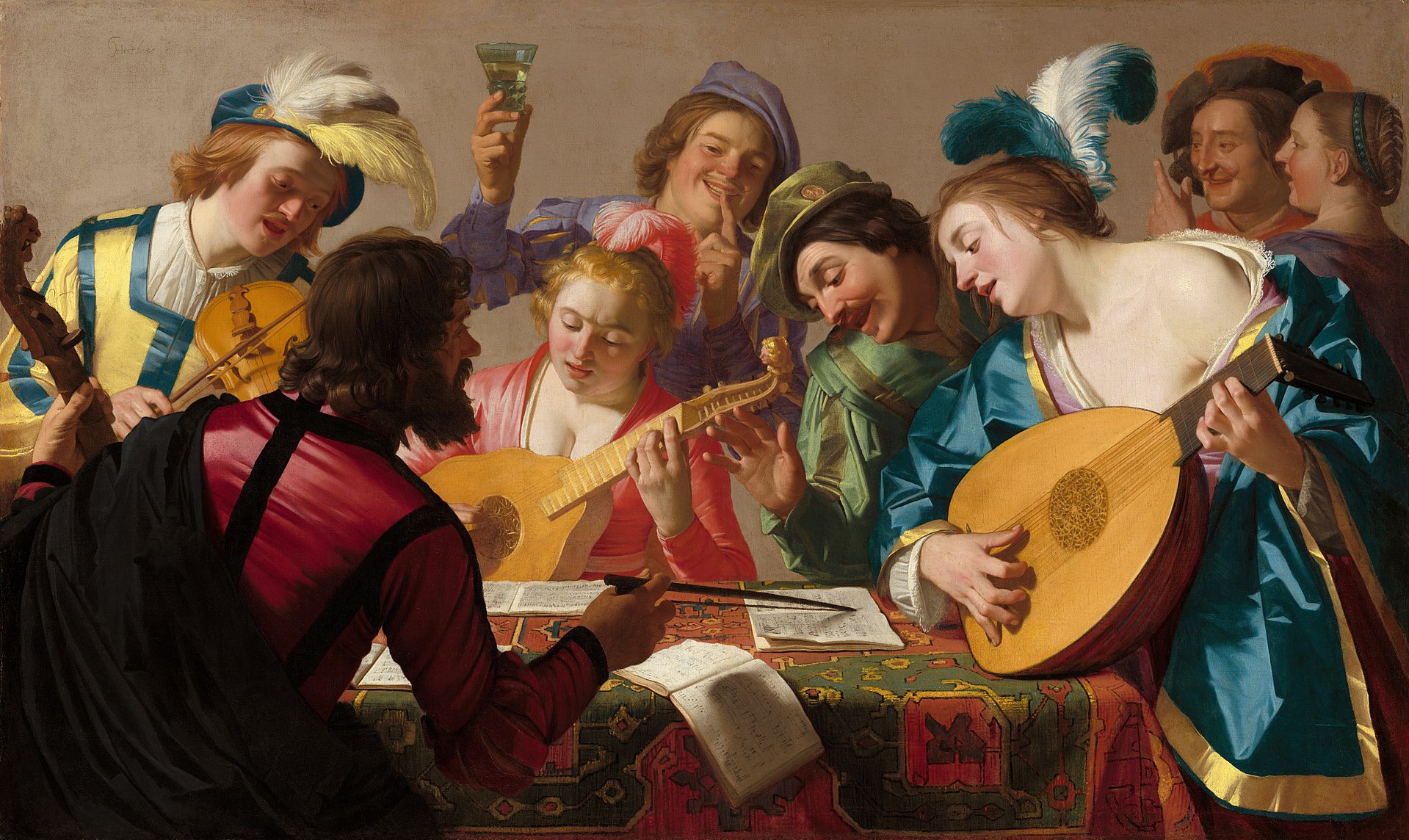11.3: Vocal Music in the Renaissance
- Page ID
- 169635
Vocal Music in The Renaissance (1400-1600).

"The Concert" by Dutch painter Gerard van Honthorst (1623), Public Domain.
The word Renaissance literally translates to "rebirth," and marks the transition that Europe experienced between the Middle Ages and modernity (beginning in 1600 in the Baroque Period, musically speaking). Originating in Italy, and spreading across Europe, Europeans began to "rediscover" ancient Greek texts. We see the rise of humanism in the Renaissance, which sought to revive ancient learning like grammar, rhetoric, poetry, and history. Throughout this period, we don't see a rejection of Christianity, but the Protestant Reformation led by Martin Luther challenges the Catholic church's reign of supremacy across both politics and religion. Considering how much music was based in Catholic tradition, Martin Luther's reformation bears significant consequences in the world of sacred music. Similar to the music in the Medieval Period, music in the Renaissance was mostly vocal, much of which was a capella, meaning there was no instrumental accompaniment. When instruments were used, they typically accompanied the vocal line by playing the same thing (with possible embellishment). Much of the music in the Renaissance was polyphonic, leaving the monophonic texture of the Middle Ages behind.
Martin Luther and the Protestant Anthem.

Martin Luther's famous 1517 act of nailing his 95 theses to the door of the church in Wittenberg began the Protestant Reformation (the word Protestant being rooted in the word protest). Among his grievances was the corruption that he saw within the Vatican and the Catholic Church in general. One of the biggest reformations within the movement affected the way that church services were conducted: throughout all of the Middle Ages, the entire Catholic service was conducted in the Latin text--Latin, being the religious language of the Christian faith. Of course, the biggest problem with this is that the average churchgoer likely did not understand anything that was chanted or spoken!
Now, with the Protestant Reformation in full swing, churches that were not aligned with the Catholic tradition could hold their services in the language of the people's locale, which meant that composers could write sacred music in their own language!
One of the most significant musical changes we see in the Protestant sacred music tradition is the rise of the Protestant anthem. These types of songs are still written today, and are found in many different denominations of the Protestant tradition. These are the English version of the Catholic motet, which is a sacred piece of choral music, but sung in Latin.
Anthems (and motets) are a capella, which means that they have no instrumental accompaniment. They are also polyphonic in texture, similar to the piece from the previous unit by Machaut.
Listen to VOICES8 perform William Byrd's "Sing Joyfully," a popular Protestant anthem that is sung in English, based off of Psalm 81. The anthem uses imitation, which is a type of compositional technique where one voice begins a melody, and is responded with the same melody by another voice (similar to "row row row your boat" sung as a round). In this anthem, William Byrd uses 6 different melodies sung at the same time!
By setting the entire psalm to song, the music's form is another example of sectional form. Each phrase of the psalm is a different melodic idea, and therefore a different section of the music. The chart below shows the psalm and how we organize the music by section:
A Sing joyfully to God our strength;
B sing loud unto the God of Jacob!
C Take the song, bring forth the timbrel,
D the pleasant harp, and the viol.
E Blow the trumpet in the new moon,
F even in the time appointed, and at our feast day.
G For this is a statute for Israel,
H and a law of the God of Jacob
When you're done listening to this short anthem, view the video presentation for this piece for a more thorough discussion of the nuances within this anthem.
(above): painting of Martin Luther by German Renaissance painter Lucas Cranach the Elder. Public Domain.
Josquin des Prez and the Secular Frottola

A 1611 woodcut of Josquin des Prez by Unknown author. Publich Domain.
Josquin des Prez (~1450-1521) was a Franco-Flemish composer who is known as the first Western composer whose fame continued after his death. He wrote much sacred music like Catholic masses and motets, as well as secular music, which had no religious meaning. Although he wrote a lot of different kinds of music, his most well-known piece is titled El Grillo," which translates to "The Cricket." This is an example of a frottola, a mostly comical polyphonic setting of a poem. Josquin wrote this silly poem about a cricket, which is translated below. The music is in ABA form, which is represented below.
In this piece, Josquin demonstrates a clever and humorous approach to writing for voice. In this piece, we see many instances of word painting: these are instances where the music accurately reflects the words being sung. There are instances where the vocalists actually sound like crickets, and other instances where the singers hold a humorously long line on the words "long line." Watch this performance of the a capella group Cantus perform this fun frottola. As you listen, pay close attention to timestamp 0:31 -- they sound like crickets chirping (this text translates to "give him ad rink so he can go on singing"). At 1:18, they hold out "longo verso" (or "long line") for an exceedingly long time. Finally, at 1:30, the group makes "buzzing" to sound like crickets! When you're done listening to the piece and following along, watch the video presentation for this piece that discusses the polyphony and the music's form in more detail.
Section Original Italian Text English Translation
A El grillo è buon cantore The cricket is a good singer
che tiene longo verso. Who can hold a long line
Dale beve grillo canta. Give him a drink so he can go on singing
B Ma non fa come gli altri uccelli, But he doesn’t do what birds do
come li han cantato un poco who after singing a while,
van' de fatto in altro loco, just go elsewhere.
sempre el grillo sta pur saldo The cricket is always steadfast
Quando la maggior è [l'] caldo when it is hottest,
alhor canta sol per amore. Then, he sings solely for love.
A El grillo è buon cantore The cricket is a good singer
che tiene longo verso. Who can hold a long line
Dale beve grillo canta. Give him a drink so he can go on singing

